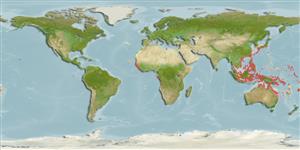Common names from other countries
Environment: milieu / climate zone / depth range / distribution range
Ecologia
; estuarina. Tropical
Eastern Central Atlantic and Western Pacific.
Length at first maturity / Tamanho / Peso / Idade
Maturity: Lm ? range ? - ? cm
Common in estuaries (Ref. 2925). Inhabits muddy sandflats and seagrass areas (Ref. 85382), also on seaweed in bays (Ref. 75835). Part of both epibenthic and arboreal communities in mangrove areas (Ref. 128397). Also found in sandy shores, near the vicinity of the depression formed during low tides to avoid desiccation (Ref. 125338).
Life cycle and mating behavior
Maturidade | Reprodução | Desova | Ovos | Fecundidade | Larvas
Members of the order Neritopsina are mostly gonochoric and broadcast spawners. Life cycle: Embryos develop into planktonic trocophore larvae and later into juvenile veligers before becoming fully grown adults.
Smith, B.D. 2003. (Ref. 3116)
Status na Lista Vermelha da IUCN (Ref. 130435)
Status no CITES (Ref. 108899)
Not Evaluated
Not Evaluated
Perigo para os humanos
Harmless
Uso pelos humanos
| FishSource |
Ferramentas
Mais informação
Idade/TamanhoCrescimentoComprimento-pesoComprimento-comprimentoMorfologiaLarvasAbundância
Fontes da internet
Estimates based on models
Preferred temperature
(Ref.
115969): 25.5 - 29.3, mean 28.6 (based on 1804 cells).
